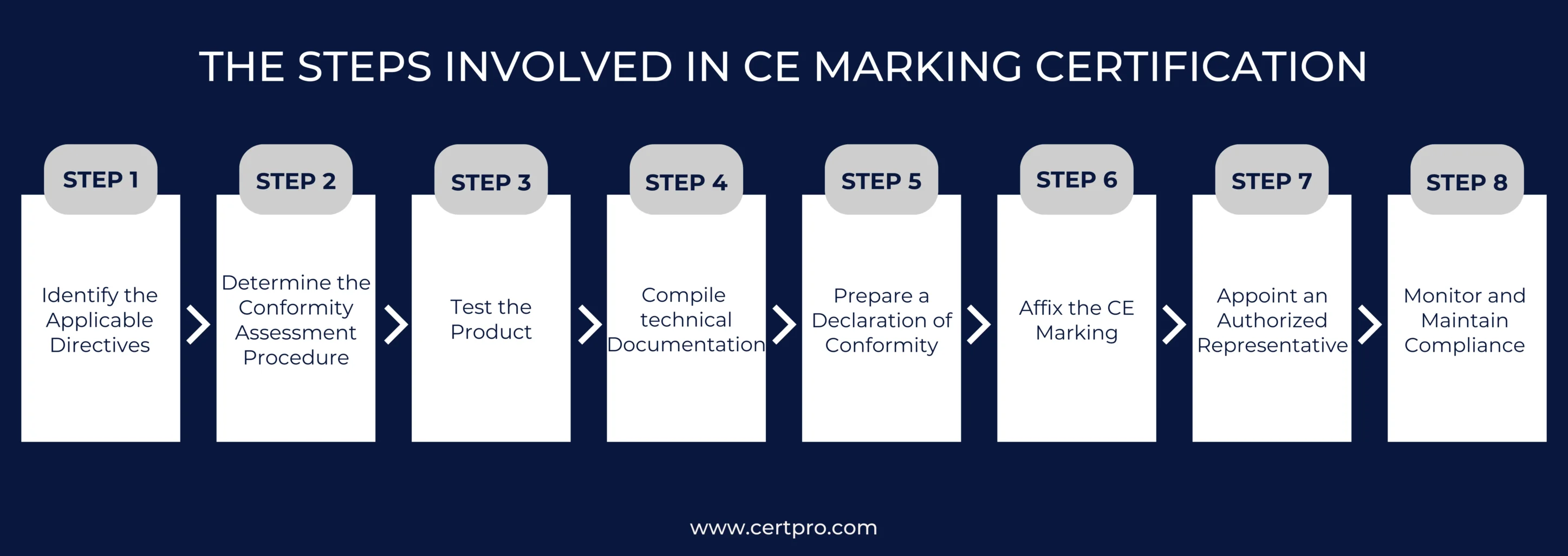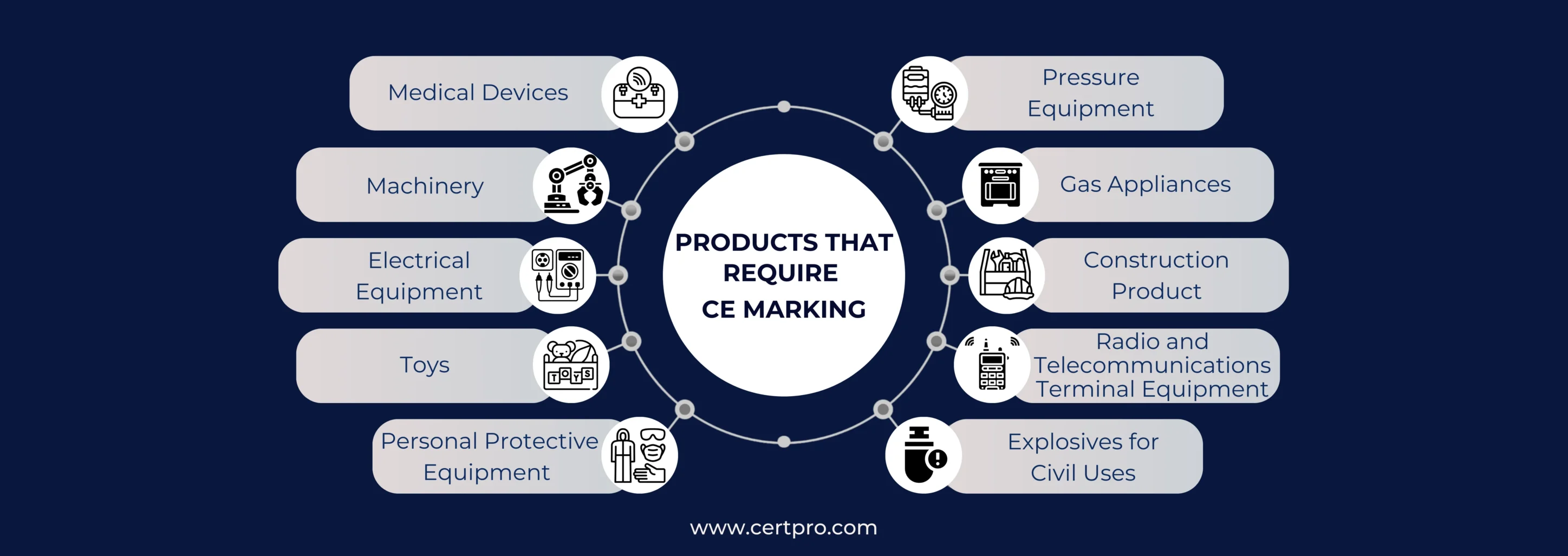ce MARK
Conformitè Europëenne
The European Economic Area (EEA) requires products to bear the CE label. The EU’s health, safety, and environmental regulations are being complied with. As a symbol of “Conformité Européene,” the CE mark guarantees compliance with all applicable EU laws and procedures. Safety, health, and environmental regulations are all included in this. The mark is a stylized “CE” that must be visible and memorable on the product or packaging. It must maintain consistent proportions and be at least 5 millimeters tall, adjusted if necessary for the product size. Additionally, the CE mark includes vital details: the manufacturer’s name, address, product ID, and affixing year. These elements provide the necessary information for traceability and accountability within the EU market.

Certification and Conformity Assessment Services by CertPro for CE Marking
CertPro provides specialist services to attain CE marking certification. As a result, we carry out exhaustive evaluations to guarantee adherence. Our team ensures compliance with EU directives and laws. They assess the environmental, health, and safety standards of products. Additionally, we publish thorough reports for openness. Obtaining the CE certification mark demonstrates a dedication to European norms, enhancing credibility and market trust. Count on CertPro for knowledgeable advice. We negotiate the challenging certification process for CE marking services.
Why Choose CertPro for CE Marking Certification?
At CertPro, we recognize the significance of choosing the right partner for your CE marking certification. Here are several crucial factors that distinguish us, along with the benefits you can anticipate when selecting CertPro:
| Factors | CertPro Advantage |
|---|---|
| Time to Certification | 4x faster than traditional approaches |
| Price | Competitive rates with flexible options |
| Process | Streamlined and efficient methodology |
| Expertise | 10+ years of industry experience |
CertPro’s Cost-Effective Approach to CE Marking Certification
CertPro provides CE marking certification services at a reasonable cost. We recognize how crucial cost management and compliance are. With our tailored strategy, you only pay for your organization’s needs, resulting in cost savings. We minimize disruptions and utilize resources efficiently to guarantee a seamless certification procedure. CertPro offers a customized pricing plan for several variables affecting total costs. Hence, CertPro provides an inexpensive substitute for CE marking certification.
| Milestone | Timeline | Cost (approx.) |
| Declaration of Conformity | 1 week | 1000 USD |
| Conformity Assessment | 2 weeks | 1500 USD |
| Certification | 1 week | 1500 USD |
| Total | 4 weeks | 4000 USD |
Understanding the Fundamentals of CE Marking
CE certification is essential for European Economic Area (EEA) items. It shows adherence to the EU’s environmental, health, and safety regulations. A product complies with EU directives and regulations if it bears the CE mark. This makes trade within the EEA unlimited and independent of the country of origin. Products must follow specific EU guidelines or rules. The RoHS Directive, for instance, restricts hazardous materials in electronics. The WEEE Directive governs their recycling and disposal.
This entails gathering technical paperwork and prominently placing the CE label. Manufacturers who want to be certified with CE marking services must abide by EU laws and guidelines. This accreditation proves that the EU criteria are being followed. It makes market access easier within the EEA. The CE symbol denotes adherence to legal requirements. It guarantees goods fulfill EU regulations. This makes it possible to enter the EEA market efficiently.
The steps involved in CE marking certification
The following are the steps that go into CE marking:
Identify the Applicable Directives: Ascertain which EU directives or rules the goods are subject to. See the details in the official journal of the European Union or get guidance from an informed body.
Determine the Conformity Assessment Procedure: Choose the most suitable method for the product’s conformance assessment. Examine EU directives and regulations or consult an alert body.
Test the Product: Manufacturers and independent testing facilities can analyze and test the product to ensure it satisfies all applicable EU regulations.
Compile Technical Documentation: Assemble documentation proving the product complies with applicable EU directives or rules. This record should include design specifications, test findings, and production procedures.
Prepare a Declaration of Conformity. This declaration attests to adherence to EU regulations. The maker or an authorized representative must sign it.
Affix the CE Marking: Label the product or its packaging with the CE mark. Make sure it is legible, readable, and unchangeable.
Appoint an Authorized Representative: Authorized representatives should be appointed. Manufacturers outside the EU should select a representative within the EU.
Monitor and Maintain Compliance: Keep an eye on and uphold compliance. Observe any new directives or legislation from the EU. Perform routine testing and address any concerns or grievances about the product.
CE marking generally requires careful planning and close attention to detail. Manufacturers should consult specialists to achieve compliance with EU regulations.

Importance and Mandate of CE Marking
The mandate of CE marking ensures products meet essential standards, including health, safety, and environmental protection. Additionally, EU law requires this for the European Economic Area (EEA). CE marking is mandatory for EEA-made products and those imported from outside the EEA. Furthermore, the EU aims to safeguard consumers from harm. Consequently, CE marking is required for this purpose. The following are some reasons why CE marking services are essential:
Legal Requirement: This is mandated by law. The CE mark is required on many products sold inside the European Economic Area (EEA). Therefore, disobedience may have legal ramifications. There may also be penalties and criminal culpability.
Safety and Health: CE certification guarantees health and safety. It ensures adherence to safety, health, and environmental regulations, safeguarding the environment, employees, and customers from hazards. Furthermore, this covers goods sold within the EEA, which also applies to goods sold in Switzerland.
Facilitating Trade: CE marking helps trade within the EU by establishing common technical and safety standards. Therefore, products must meet these standards to be sold in the EEA.
Market Access: Many non-EU nations recognize CE marking as a product quality and safety standard. Thus, manufacturers gain increased market access and export opportunities.
Competitive Advantage: CE marking provides a competitive advantage. It demonstrates that products meet necessary standards, increasing consumer trust and confidence.
The CE mark demonstrates adherence to EU regulations and that the importer took the appropriate safety measures. As a result, it guarantees that goods adhere to pertinent laws. Crucially, noncompliance results in legal action. Thus, the CE certification mark is essential for consumer protection.
Requirements for CE marking certification, manufacturing, products, and countries
The requirements for the CE certification mark vary depending on the product category and the applicable EU directive or regulation.
- Identify the applicable EU directives or regulations for the product.
- Determine the product’s conformity assessment procedure. This may include self-certification, type examination, or full quality assurance.
- Evaluate the product to ensure it meets essential health standards. It must also meet safety and environmental protection standards specified by the relevant EU directive or regulation.
- Then, create a technical file. This file should include all relevant documentation about the product. Examples include test reports, drawings, and instructions for use.
- After that, release a Conformity Declaration. This declares the product meets the essential requirements of the applicable EU directive or regulation. Lastly, the CE marking is affixed to the product. This marking indicates compliance with the relevant EU requirements.
It is important to note that CE certification requirements can be intricate. These requirements cover environmental protection, health, and safety. They also protect customers against dangerous or non-compliant products.
Manufacturers that require CE marking
CE marking places certain obligations on manufacturers, importers, distributors, and EU customers. First, manufacturers must ensure their products meet the relevant requirements. After that, they must affix the CE mark to their products. Moreover, importers must confirm that imported products comply with EU requirements. Additionally, they must check that the CE mark is affixed, and distributors must verify its presence. Also, they must ensure the required documentation is available.
Similarly, EU customers must check that products bear the CE mark. Besides that, they need to confirm the necessary documentation is included. All parties in the supply chain must cooperate for certification. This cooperation ensures compliance with CE marking requirements.
Products that require CE marking
Products that need CE marking fall under the relevant EU directives, regulations, and standards. This category includes various products. Manufacturers or importers decide if their product is subject to this regulation and ensure all required conformity assessment processes are carried out.

Countries that require CE marking
Products sold within the European Economic Area must bear the CE mark. The 27 member states of the EU are included in this. Nevertheless, Switzerland, Turkey, Bulgaria, Belgium, and Austria want CE labeling. Moreover, CE labeling is required in Greece, Germany, France, Italy, Hungary, and Ireland. It also includes Poland, the Netherlands, and Malta. Slovakia, Portugal, and Romania demand CE marking. Finally, Sweden, Slovenia, and Spain also require it.
Every product sold in these nations must have a CE mark. A new UK goods mark was implemented after the UK departed from the EU. This mark, known as the UKCA (UK Conformity Assessed) marking, applies to British goods.
Nonetheless, the EU and Northern Ireland continue to recognize the CE marking. This implies that goods sold in the EU or Northern Ireland must have the CE mark. On the other hand, goods sold in the United Kingdom must have the UKCA mark on them.
Benefits of CE Marking Certification
Certification with the CE mark verifies that a product meets the authorities’ standards. A product requires specific requirements before it is sold in the European market. There are numerous advantages as well. First, it opens up the market to more people. Not only that, but it also guarantees legal compliance and boosts customer confidence. This reduces accountability while eventually increasing sales. To sum up, it raises the reputation of the brand.
The Cost of Obtaining CE Marking Certification
Acquiring approval for CE marking might come at a hefty price. This is dependent on the type of product. Any applicable EU directives or regulations also impact CE mark certification cost. Additionally, one reason is the intricacy of the conformity evaluation process. Moreover, the price is affected by the notification body’s involvement.
Some costs associated with CE marking certification include:
Testing Costs: Testing is not free. It is an essential step in the CE marking process. The applicable EU directive or rule specifies these requirements.
Technical Documentation Costs: Technical documentation costs are high. It costs money to create technical files and other documentation. These files have something to do with the product.
Notified Body Fees: Notified bodies can charge for their services. This is also required if their participation in the conformance assessment process is necessary.
Travel costs: The manufacturer or importer must conduct testing. This also applies if they need to collaborate with a notified body.
Overall, the cost of CE mark certification can vary widely. It can be a significant investment for manufacturers or importers. However, the benefits of CE marking certification are substantial. For example, it offers increased market access. Additionally, it ensures compliance with EU regulations. Furthermore, it improves product quality and safety. In the long run, these benefits can outweigh the costs.
Validity of CE Mark Certification
The CE mark has no time limit. This is valid because the product complies with all applicable EU guidelines and laws. Ongoing compliance, though, is a need for producers. They achieve this through routine evaluation and observation of the product. A reassessment can be required if the product undergoes any changes. This also holds for modifications to the production process. Reevaluation is necessary for each modification that impacts conformance. There may also be the introduction of new rules or guidelines. In such a case, a compliance reevaluation of the product is necessary.
Overall, the CE mark remains valid. This validity lasts as long as the product maintains conformity. It must meet all applicable requirements.
Simplify Your CE Marking Certification Process with CertPro’s Expertise
CertPro provides thorough audits, consulting, and certification services to help organizations become certified with CE markings. Our knowledgeable team uses the newest technologies to monitor and evaluate products regularly to guarantee continuous compliance.
CertPro’s primary goal is to provide customers with the best service possible during certification. We work closely with customers to fully understand their needs before devising custom solutions. By choosing CertPro, manufacturers can reduce the stress related to CE marking.
FAQ’s
What is "CE marking self-certification"?
CE marking self-certification means that the manufacturer of a product takes responsibility for ensuring that the product complies with the relevant EU directives and regulations. The manufacturer conducts the necessary conformity assessment procedures and prepares the technical documentation and Declaration of Conformity without involvement from a third-party certifying body.
What is the consequence of non-compliance with CE marking?
Non-compliance with CE marking has consequences for manufacturers, importers, and distributors. They can face legal penalties such as fines, product recalls, or even bans on selling their products in the European market. In addition, non-compliant products can pose a risk to consumers’ health and safety, potentially resulting in injuries or losses, as well as damaging the reputation and trustworthiness of the company. Therefore, businesses must ensure that the products meet all applicable EU requirements and bear the CE marking before placing them on the market.
Can a product be imported from outside the EEA without CE marking?
No, a product cannot be imported from outside the European Economic Area (EEA) without CE marking if it falls under the scope of the relevant EU directives and regulations. CE marking is mandatory for products covered by these regulations, and it indicates that the product conforms to the applicable EU health, safety, and environmental protection requirements. Customs authorities may detain or seize products without the CE marking, and the importer may be subject to legal sanctions.
What is the role of notified bodies in CE marking?
For some products, notified bodies are independent organizations that EU member states have designated to carry out conformity assessments and offer certification services. Their role is to evaluate and verify the conformity of products with the applicable EU requirements and also give technical support and guidance to manufacturers and importers.
Do all products require third-party testing for CE marking?
No, not all products require third-party testing for CE marking. The need for third-party testing depends on the specific directives and regulations applicable to the product. Some products allow manufacturers to self-certify their conformity without involving a third-party testing body, while others may require the mandatory involvement of a notified body for testing and certification.
IT COMPLIANCE IN 2024: ESSENTIAL TRENDS AND BEST PRACTICES
IT compliance is essential for every organization to secure the integrity and accountability of data. The process also helps develop the business and enhance its profitability. In today’s digital era, IT compliance has more than just a regulatory checkbox. It plays a...
POLICY MANAGEMENT SYSTEM: ESSENTIAL TOOLS FOR AUTOMATION AND SIMPLIFICATION
Growing businesses indicates that you become a master in your field and accurately manage all business-related policies. However, managing company policies can be daunting significantly when your business expands. Here, an effective policy management system can help...
NAVIGATING DATA PRIVACY FRAMEWORKS: A COMPREHENSIVE GUIDE
Globalization has intense effects on business functioning and scaling. In today's digital world, companies are generating an unprecedented rate of data that requires protection from emerging cyber threats. In addition, recurring data breaches and privacy concerns make...



